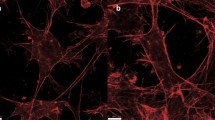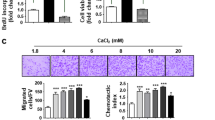Abstract
Bone remodeling is strictly mediated by the coupled activities of osteoblasts and osteoclasts, which are responsible for bone formation and resorption, respectively. Although many papers have been published on the mechanical responses of osteoblasts and osteoclasts, little is known about their communication during mechanical loading. In this study, a novel co-culture system was first established using Transwell culture inserts; MC3T3-E1 cells were embedded in the lower compartment of the inserts, and RAW264.7 cells were co-cultured in the upper compartment. The MC3T3-E1 cells were subjected to a mechanical strain of 2500 με at 0.5 Hz to investigate the effect of strain-loaded osteoblasts on co-cultured osteoclasts. The results showed that osteoblast-like cells were activated with an increase of alkaline phosphatase (ALP) activities. The strain-conditioned medium caused decreased activity of tartrate-resistant acid phosphatase and reduced the number of mature multinucleated osteoclasts, which subsequently resulted in the suppressed formation of resorption pits. The expression levels of cathepsin-K and matrix metalloproteinase-9 were also depressed by the strain-conditioned medium. In addition, we found that the expression ratio between osteoprotegerin (OPG) and receptor activator of NF-kB ligand in osteoblasts was significantly up-regulated due to the enhanced levels of OPG. In summary, we conclude that the strain-stimulated osteoblasts inhibited the differentiation and bone resorption of osteoclasts and that the mechanism was associated with the increased secretion of OPG in osteoblasts.








Similar content being viewed by others
References
Asagiri, M., and H. Takayanagi. The molecular understanding of osteoclast differentiation. Bone 40(2):251–264, 2007.
Brockstedt, H., J. Bollerslev, F. Melsen, et al. Cortical bone remodeling in autosomal dominant osteopetrosis: a study of two different phenotypes. Bone 18(1):67–72, 1996.
Cheng, T., N. J. Pavlos, C. Wang, et al. Mutations within the TNF-like core domain of RANKL impair osteoclasts differentiation and activation. Mol. Endocrinol. 23(1):35–46, 2009.
Dalbeth, N., B. Pool, T. Smith, et al. Circulating mediators of bone remodeling in psoriatic arthritis: implication for disordered osteoclastogenesis and bone erosion. Arthritis Res. Ther. 12(4):R164, 2010.
Deyama, Y., S. Takeyama, M. Koshikawa, et al. Osteoblast maturation suppressed osteoclastogenesis in coculture with bone marrow cells. Biochem. Biophys. Res. Commun. 274(1):249–254, 2000.
Di Palma, F., M. Douet, C. Boachon, et al. Physiological strains induce differentiation in human osteoblasts cultured on orthopaedic biomaterial. Biomaterials 24(18):3139–3151, 2003.
Eriksen, E. F. Cellular mechanisms of bone remodeling. Rev. Endocr. Metab. Disord. 11(4):219–227, 2010.
Guo, C., Y. X. Yan, X. Z. Zhang, et al. Effects of mechanical strain strength on differentiation of mouse monocytes RAW264.7 into osteoclasts. J. Clin. Rehabil. Tissue Eng. Res. 13(37):7211–7216, 2009; in Chinese.
Hatherell, K., P. O. Couraud, I. A. Romero, et al. Development of a three-dimensional, all-human in vitro model of the blood–brain barrier using mono-, co-, and tri-cultivation Transwell models. J. Neurosci. Methods 199(2):223–229, 2011.
Ichimiya, H., T. Takahashi, W. Ariyoshi, et al. Compressive mechanical stress promotes osteoclast formation through RANKL expression on synovial cells. Oral Surg. Oral Med. Oral Pathol. Oral Radiol. Endod. 103(3):334–341, 2007.
Jones, G. L., A. Motta, M. J. Marshall, et al. Osteoblast: osteoclast co-cultures on silk fibroin, chitosan and PLLA films. Biomaterials 30(29):5376–5384, 2009.
Kadow-Romacker, A., J. E. Hoffmann, G. Duda, et al. Effect of mechanical stimulation on osteoblast- and osteoclast-like cells in vitro. Cells Tissues Organs 190(2):61–68, 2009.
Kreja, L., A. Liedert, S. Hasni, et al. Mechanical regulation of osteoclastic genes in human osteoblasts. Biochem. Biophys. Res. Commun. 368(3):582–587, 2008.
Lemaire, V., F. L. Tobin, L. D. Greller, et al. Modeling the interactions between osteoblast and osteoclast activities in bone remodeling. J. Theor. Biol. 229(3):293–309, 2004.
Lerner, U. H. Bone remodeling in post-menopausal osteoporosis. J. Dent. Res. 85(7):584–595, 2006.
Mullender, M., A. J. El Haj, Y. Yang, et al. Mechanotransduction of bone cells in vitro: mechanobiology of bone tissue. Med. Biol. Eng. Comput. 42(1):14–21, 2004.
Nabavi, N., A. Khandani, A. Camirand, et al. Effects of microgravity on osteoclast bone resorption and osteoblast cytoskeletal organization and adhesion. Bone 49(5):965–974, 2011.
Quinn, J. M., and M. T. Gillespie. Modulation of osteoclast formation. Biochem. Biophys. Res. Commun. 328(3):739–745, 2005.
Schriefer, J. L., S. J. Warden, L. K. Saxon, et al. Cellular accommodation and the response of bone to mechanical loading. J Biomech. 38(9):1838–1845, 2005.
Sundaram, K., R. Nishimura, J. Senn, et al. RANK ligand signaling modulates the matrix metalloproteinase-9 gene expression during osteoclast differentiation. Exp. Cell Res. 313(1):168–178, 2007.
Suzuki, N., Y. Yoshimura, Y. Deyama, et al. Mechanical stress directly suppresses osteoclast differentiation in RAW 264.7 cells. Int. J. Mol. Med. 21(3):291–296, 2008.
Tan, S. D., T. J. de Vries, A. M. Kuijpers-Jagtman, et al. Osteocytes subjected to fluid flow inhibit osteoclast formation and bone resorption. Bone 41(5):745–751, 2007.
Tang, L., Z. Lin, and Y. M. Li. Effects of different magnitudes of mechanical strain on osteoblasts in vitro. Biochem. Biophys. Res. Commun. 344(1):122–128, 2006.
Tang, L. L., Y. L. Wang, J. Pan, et al. The effect of step-wise increased stretching on rat calvarial osteoblast collagen production. J. Biomech. 37(1):157–161, 2004.
Troen, B. R. Molecular mechanisms underlying osteoclast formation and activation. Exp. Gerontol. 38(6):605–614, 2003.
Wang, L., J. Y. Li, X. Z. Zhang, et al. Involvement of p38MAPK/NF-κB signaling pathway in osteoblasts differentiation in response to mechanical stretch. Ann. Biomed. Eng. 40(9):1884–1894, 2012.
Wang, L., X. Z. Zhang, Y. Guo, et al. Involvement of BMPs/Smad signaling pathway in mechanical response in osteoblasts. Cell. Physiol. Biochem. 26(6):1093–1102, 2010.
Xiong, J. H., and C. A. O’Brien. Osteocyte RANKL: new insight into the control of bone remodeling. J. Bone Miner. Res. 27(3):499–505, 2012.
Xiong, J. H., M. Onal, R. L. Jilka, et al. Matrix-embedded cells control osteoclast formation. Nat. Med. 17(10):1235–1241, 2012.
Yan, Y. X., Y. W. Gong, Y. Guo, et al. Mechanical strain regulates osteoblast proliferation through integrin-mediated ERK activation. PLoS One 7(4):e35709, 2012.
Yang, G., M. Zaidi, W. Zhang, et al. Functional grouping of osteoclast genes revealed through microarray analysis. Biochem. Biophys. Res. Commun. 366(2):352–359, 2008.
Zhang, Q. H., X. Liang, B. M. Zhu, et al. Effects of fluid shear stress on mRNA expression of carbonic anhydrase II in polarized rat osteoclasts. Cell Biol. Int. 30(9):714–720, 2006.
Acknowledgments
This work was supported by grants from the National Nature Science Foundation of China (No. 10832012), the Tianjin Science Foundation of China (No. 10JCYBJC14700), the Tianjin Science Foundation of China (No. 13JCQNJC13200) and the Tianjin Public Health Bureau Science Foundation of China (No. 2010KY03).
Conflict of interest
All authors certify that they have no financial or personal relationships that could inappropriately influence or bias this work.
Author information
Authors and Affiliations
Corresponding author
Additional information
Associate Editor Cheng Dong oversaw the review of this article.
Jianyu Li and Zongming Wan contributed equally to this work.
Rights and permissions
About this article
Cite this article
Li, J., Wan, Z., Liu, H. et al. Osteoblasts Subjected to Mechanical Strain Inhibit Osteoclastic Differentiation and Bone Resorption in a Co-Culture System. Ann Biomed Eng 41, 2056–2066 (2013). https://doi.org/10.1007/s10439-013-0810-x
Received:
Accepted:
Published:
Issue Date:
DOI: https://doi.org/10.1007/s10439-013-0810-x




